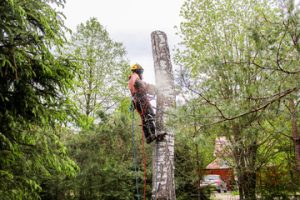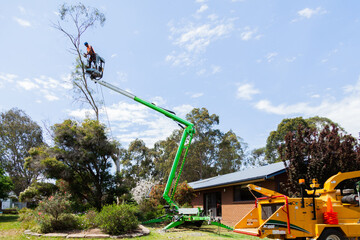Tree removal protects homes and landscapes from hazards. Damaged or unstable trees can fall unexpectedly. Removing them prevents injuries. It also safeguards surrounding structures.

Tree health assessment is crucial before removal. Professionals check for decay, pests, and root damage. Proper evaluation determines the safest approach. Planning reduces accidents and costs.
Urban tree removal has unique challenges. Tight spaces and overhead wires complicate work. Experts carefully plan each cut. Safety of people and property is a priority.
Seasonal timing affects tree removal efficiency. Frozen ground or wet soil impacts stability. Certain seasons increase wildlife activity. Professionals schedule work to minimize risks.
Advanced equipment makes removal faster and safer. Cranes, ropes, and saws handle large trees. Technology improves precision. It reduces manual labor and danger.
Emergency removals often follow storms. High winds or heavy snow can topple trees. Quick response prevents further damage. Professionals assess hazards immediately.
Sectional removal is common for large trees. Cutting the tree in parts prevents uncontrolled falls. Pulleys and ropes guide heavy sections. Controlled removal enhances safety.
Tree removal can improve sunlight exposure. Overgrown branches block light for gardens and lawns. Clearing trees revitalizes plants. Sunlight boosts growth and energy efficiency.
Environmental considerations are part of modern practices. Trees may be recycled into mulch or timber. Wood reuse reduces waste. Sustainability is integrated into removal projects.
Root systems require careful attention. Large roots can affect foundations or underground utilities. Excavation must prevent soil destabilization. Professionals plan for minimal disruption.
Tree disease management often involves removal. Infected trees can spread pests and fungi. Eliminating them protects healthy plants. Sanitation procedures prevent contamination.
Stump grinding follows most removals. Grinding prevents regrowth and trip hazards. It also improves appearance. Proper equipment completes the process efficiently.
Tree removal intersects with landscaping design. Clearing trees can create space for new layouts. Light and visibility improve. Professionals coordinate with designers for optimal results.
Chemical treatments may prevent stump sprouting. Properly applied solutions stop regrowth. This reduces future maintenance. Safety measures protect soil and water.
Trees near utilities require special care. Overhead power lines and underground pipes pose risks. Professionals coordinate with providers. Safety remains the top priority.
Wildlife relocation is sometimes necessary. Birds, squirrels, or insects may inhabit the tree. Professionals move animals safely. Environmental impact is minimized.
Debris management is an essential step. Branches and logs are removed or recycled. Mulching enhances soil quality. Efficient cleanup improves workflow.
Tree removal contributes to property safety. Roots can lift sidewalks or block drainage. Eliminating hazardous trees prevents accidents. Regular monitoring maintains safety.
Directional cutting techniques guide trees safely. Professionals plan cuts to control the fall. Angles and notches ensure predictability. Proper technique prevents property damage.
Tree removal affects soil moisture and erosion. Roots retain water and anchor soil. Professionals plan irrigation and soil stabilization. Maintaining soil health prevents long-term problems.
Large-scale removals need logistics planning. Transporting debris and equipment requires coordination. Scheduling crews reduces downtime. Efficiency lowers costs and time.
Tree removal can enhance aesthetic appeal. Overgrown trees may obscure views or architectural features. Clearing them improves property visuals. Professionals balance functionality and beauty.
Emergency protocols standardize response. Teams follow defined procedures. Safety for workers, residents, and structures is ensured. Quick action reduces risk and damage.
Tree removal intersects with historical or protected landscapes. Certain trees may have cultural or ecological significance. Experts assess value before removal. Preservation may modify removal methods.
Soil and nutrient restoration is essential after removal. Excavated areas need enrichment. New plantings thrive with proper preparation. Professionals maintain landscape health.
Stump and root decay can attract pests. Termites and rodents use old wood for shelter. Grinding and treatment prevent infestations. Monitoring ensures long-term protection.
Tree removal integrates with urban planning. Sidewalks, roads, and infrastructure require clear areas. Professionals coordinate with planners. Safety and functionality are considered alongside greenery.
Community education often accompanies removal projects. Homeowners learn about tree care and safe practices. Awareness prevents unnecessary removal. Responsible stewardship benefits the environment.
Tree removal impacts water management. Roots absorb significant water, affecting drainage. Removing trees may require irrigation adjustments. Professionals plan to maintain soil stability.
Equipment maintenance is critical. Chainsaws, ropes, and cranes must function reliably. Regular checks prevent accidents. Well-maintained tools improve efficiency.
Tree removal in residential areas requires neighbor communication. Notices and signage reduce conflicts. Scheduling minimizes disruption. Courtesy and safety are emphasized.
Green and sustainable practices are emerging. Trees can be replanted to replace removed ones. Mulch and timber are repurposed. Professionals prioritize environmental responsibility.
Technology aids removal decisions. Drones and sensors assess tree stability. Mapping identifies obstacles. Data-driven planning ensures precision and safety.
Tree removal intersects with landscape design goals. Clearing trees can open space for new plantings or structures. Professionals balance visual appeal with ecological impact. Design considerations enhance functionality.
Emergency response teams handle high-risk removals. Fallen trees on roads or near buildings require immediate action. Training ensures safety and speed. Professionals mitigate damage effectively.
Tree removal affects ecosystems. Birds, insects, and small mammals may lose habitat. Experts relocate wildlife when feasible. Environmental impact is considered alongside human safety.
Insurance requirements dictate professional involvement. DIY removals can void coverage. Licensed providers ensure compliance. Documentation protects all parties.
Tree removal may improve energy efficiency. Removing shade or overcrowding allows sunlight to warm buildings. Proper planning maximizes light exposure. Energy savings benefit homeowners.
Urban tree removal requires careful coordination. Street trees may obstruct traffic or utilities. Professionals manage equipment placement and timing. Safety and efficiency are maintained.
Tree removal projects often involve multiple specialties. Arborists, landscapers, and removal crews collaborate. Coordination ensures proper care and disposal. Expertise spans health, safety, and aesthetics.
Emergency preparedness is part of professional service. Teams respond rapidly to fallen or dangerous trees. Safety protocols protect workers and property. Efficiency prevents escalation of damage.
Stump and debris removal improves usability. Vacant areas can be converted into gardens or play spaces. Grinding or hauling completes the process. Spaces are repurposed safely and efficiently.
Tree removal contributes to property longevity. Problematic roots and unstable trees threaten structures. Early removal prevents costly repairs. Professionals maintain long-term landscape health.
Tree removal continues to evolve with innovation. Advanced tools, environmental awareness, and planning improve outcomes. Safety, efficiency, and sustainability guide each project. Every removal is executed responsibly and effectively.
